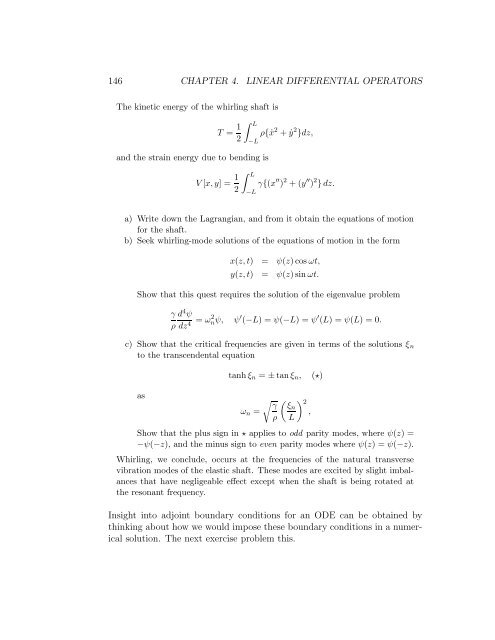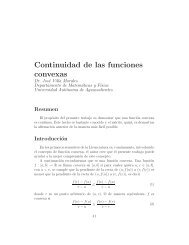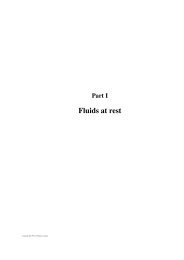Chapter 4 Linear Differential Operators
Chapter 4 Linear Differential Operators
Chapter 4 Linear Differential Operators
You also want an ePaper? Increase the reach of your titles
YUMPU automatically turns print PDFs into web optimized ePapers that Google loves.
146 CHAPTER 4. LINEAR DIFFERENTIAL OPERATORS<br />
The kinetic energy of the whirling shaft is<br />
T = 1<br />
L<br />
ρ{ ˙x<br />
2 −L<br />
2 + ˙y 2 }dz,<br />
and the strain energy due to bending is<br />
V [x, y] = 1<br />
L<br />
γ{(x<br />
2 −L<br />
′′ ) 2 + (y ′′ ) 2 } dz.<br />
a) Write down the Lagrangian, and from it obtain the equations of motion<br />
for the shaft.<br />
b) Seek whirling-mode solutions of the equations of motion in the form<br />
x(z, t) = ψ(z) cos ωt,<br />
y(z, t) = ψ(z) sin ωt.<br />
Show that this quest requires the solution of the eigenvalue problem<br />
γ d<br />
ρ<br />
4ψ dz4 = ω2 nψ, ψ′ (−L) = ψ(−L) = ψ ′ (L) = ψ(L) = 0.<br />
c) Show that the critical frequencies are given in terms of the solutions ξn<br />
to the transcendental equation<br />
as<br />
tanh ξn = ± tan ξn, (⋆)<br />
ωn =<br />
γ<br />
ρ<br />
2 ξn<br />
,<br />
L<br />
Show that the plus sign in ⋆ applies to odd parity modes, where ψ(z) =<br />
−ψ(−z), and the minus sign to even parity modes where ψ(z) = ψ(−z).<br />
Whirling, we conclude, occurs at the frequencies of the natural transverse<br />
vibration modes of the elastic shaft. These modes are excited by slight imbalances<br />
that have negligeable effect except when the shaft is being rotated at<br />
the resonant frequency.<br />
Insight into adjoint boundary conditions for an ODE can be obtained by<br />
thinking about how we would impose these boundary conditions in a numerical<br />
solution. The next exercise problem this.




